Ore reduction process using carbon based materials having a low sulfur content and titanium oxide and iron metallization product therefrom
a carbon based material and ore reduction technology, which is applied in the field of beneficiation of titanium oxidecontaining ores, can solve the problems of large and easily recoverable iron granules, incident and insignificant process parts, and pose processing challenges, and achieve the effect of reducing and melting of agglomerates
- Summary
- Abstract
- Description
- Claims
- Application Information
AI Technical Summary
Benefits of technology
Problems solved by technology
Method used
Image
Examples
example 1
[0071]In this Example the agglomerates contained too much carbon. Tablets were prepared by mixing and compacting together, at ambient temperature, 79.7 percent by weight ilmenite ore (61% TiO2, based on the total weight of the ore), and 20.3 percent coal (71% fixed carbon, based on proximate analysis) into cylinders 20 mm in diameter and 7 mm thick. Residual water was removed from the tablets by drying. The dried tablets were placed on a bed of coke breeze in an alumina crucible and moved into a tube furnace which had been heated to 1600° C. under a nitrogen atmosphere. The tube furnace is of conventional design using a high purity alumina tube as a retort. The furnace temperature dropped on the order of about 50° C. when the tablets were initially added. The temperature increased back to the starting temperature. 25 minutes after the tablets were added, the tablets were removed from the furnace and allowed to cool. The tablets retained their original shape which indicated that the ...
example 2
[0073]In this Example the temperature inside the furnace was too low. Tablets were prepared by mixing and compacting together, at ambient temperature, 95.5 percent by weight ilmenite ore (61% TiO2, based on the total weight of the ore), 3 percent coal (71% fixed carbon), and 1.5 percent wheat flour binder into cylinders 20 mm in diameter and 7 mm thick. A small amount of binder was needed because of the lower carbon content of the tablets. Residual water was removed from the tablets by drying. The dried tablets were placed on a bed of coke breeze in an alumina crucible and moved into a tube furnace which had been heated to 1600° C. under a nitrogen atmosphere. The furnace temperature dropped on the order of about 50° C. when the tablets were initially added. The temperature gradually increased back to the starting temperature. 25 minutes after the tablets were added, the tablets were removed from the furnace and allowed to cool. Distortion and glassy appearance indicated that the ta...
example 3
[0074]Tablets were prepared by mixing and compacting together, at ambient temperature, 93.5 percent by weight ilmenite ore (61% TiO2), 5.5 percent coal (71% fixed carbon), and 1 percent wheat flour binder into cylinders 20 mm in diameter and 7 mm thick. Residual water was removed from the tablets by drying. The dried tablets were placed on a bed of coke breeze in an alumina crucible and moved into a furnace which had been heated to 1675° C. under an argon atmosphere. The furnace temperature dropped on the order of about 50° C. when the tablets were initially added. The temperature gradually increased back to the starting temperature. 25 minutes after the tablets were added, the tablets were removed and allowed to cool. Distortion and glassy appearance indicated that the tablets had melted and re-solidified. Iron metallization was found to be greater than 95% based on quantitative x-ray diffraction analysis. The average metallic iron granule size was more than 500 microns with 95% of...
PUM
| Property | Measurement | Unit |
|---|---|---|
| particle size diameter | aaaaa | aaaaa |
| temperature | aaaaa | aaaaa |
| temperature | aaaaa | aaaaa |
Abstract
Description
Claims
Application Information
 Login to View More
Login to View More - R&D
- Intellectual Property
- Life Sciences
- Materials
- Tech Scout
- Unparalleled Data Quality
- Higher Quality Content
- 60% Fewer Hallucinations
Browse by: Latest US Patents, China's latest patents, Technical Efficacy Thesaurus, Application Domain, Technology Topic, Popular Technical Reports.
© 2025 PatSnap. All rights reserved.Legal|Privacy policy|Modern Slavery Act Transparency Statement|Sitemap|About US| Contact US: help@patsnap.com



